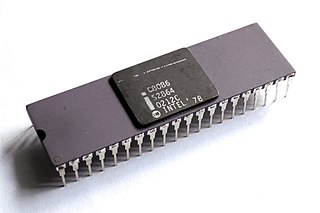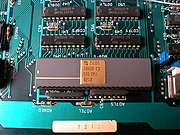
The Intel 8080 ("eighty-eighty") is the second 8-bit microprocessor designed and manufactured by Intel. It first appeared in April 1974 and is an extended and enhanced variant of the earlier 8008 design, although without binary compatibility. The initial specified clock rate or frequency limit was 2 MHz, with common instructions using 4, 5, 7, 10, or 11 cycles. As a result, the processor is able to execute several hundred thousand instructions per second. Two faster variants, the 8080A-1 and 8080A-2, became available later with clock frequency limits of 3.125 MHz and 2.63 MHz respectively. The 8080 needs two support chips to function in most applications: the i8224 clock generator/driver and the i8228 bus controller. It is implemented in N-type metal–oxide–semiconductor logic (NMOS) using non-saturated enhancement mode transistors as loads thus demanding a +12 V and a −5 V voltage in addition to the main transistor–transistor logic (TTL) compatible +5 V.

The 8086 is a 16-bit microprocessor chip designed by Intel between early 1976 and June 8, 1978, when it was released. The Intel 8088, released July 1, 1979, is a slightly modified chip with an external 8-bit data bus, and is notable as the processor used in the original IBM PC design.

The Motorola 6809 ("sixty-eight-oh-nine") is an 8-bit microprocessor with some 16-bit features. It was designed by Motorola's Terry Ritter and Joel Boney and introduced in 1978. Although source compatible with the earlier Motorola 6800, the 6809 offered significant improvements over it and 8-bit contemporaries like the MOS Technology 6502, including a hardware multiplication instruction, 16-bit arithmetic, system and user stack registers allowing re-entrant code, improved interrupts, position-independent code and an orthogonal instruction set architecture with a comprehensive set of addressing modes.

The Z80 is an 8-bit microprocessor introduced by Zilog as the startup company's first product. The Z80 was conceived by Federico Faggin in late 1974 and developed by him and his 11 employees starting in early 1975, before going on sale in July 1976. The processor is a software-compatible with the Intel 8080 but with several enhancements and at a lower price. Like the 8080, the Z80 was mainly aimed at embedded systems, but it became one of the most widely used CPUs in home computers of the late 1970s and early 1980s. The Zilog Z80 was also common in military applications, musical equipment, and coin-operated arcade games of the era, including Pac-Man.

Zilog, Inc. is an American manufacturer of microprocessors and 8-bit and 16-bit microcontrollers. It is also a supplier of application-specific embedded system-on-chip (SoC) products.

The Intel 4004 is a 4-bit central processing unit (CPU) released by Intel Corporation in 1971. Sold for US$60, it was the first commercially produced microprocessor, and the first in a long line of Intel CPUs.
The Zilog Z800 was a 16-bit microprocessor designed by Zilog and meant to be released in 1985. It was instruction compatible with their existing Z80, and differed primarily in having on-chip cache and a memory management unit (MMU) to provide a 16 MB address range. It also added a huge number of new more orthogonal instructions and addressing modes.

The DECstation was a brand of computers used by DEC, and refers to three distinct lines of computer systems—the first released in 1978 as a word processing system, and the latter two both released in 1989. These comprised a range of computer workstations based on the MIPS architecture and a range of PC compatibles. The MIPS-based workstations ran ULTRIX, a DEC-proprietary version of UNIX, and early releases of OSF/1.

Masatoshi Shima is a Japanese electronics engineer. He was one of the architects of the world's first microprocessor, the Intel 4004. In 1968, Shima worked for Busicom in Japan, and did the logic design for a specialized CPU to be translated into three-chip custom chips. In 1969, he worked with Intel's Ted Hoff and Stanley Mazor to reduce the three-chip Busicom proposal into a one-chip architecture. In 1970, that architecture was transformed into a silicon chip, the Intel 4004, by Federico Faggin, with Shima's assistance in logic design.

The Zilog Z180 eight-bit processor is a successor of the Z80 CPU. It is compatible with the large base of software written for the Z80. The Z180 family adds higher performance and integrated peripheral functions like clock generator, 16-bit counters/timers, interrupt controller, wait-state generators, serial ports and a DMA controller. It uses separate read and write strobes, sharing similar timings with the Z80 and Intel processors. The on-chip memory management unit (MMU) has the capability of addressing up to 1 MB of memory. It is possible to configure the Z180 to operate as the Hitachi HD64180.
The Z80000 is Zilog's 32-bit processor, first released in 1986. It is essentially a 32-bit expansion of its 16-bit predecessor, the Zilog Z8000. It includes multiprocessing capability, a six-stage instruction pipeline, and a 256-byte cache. Its memory addressing system can access 4 gigabytes of RAM. It can execute code written for the Z8000, but is not compatible with the Z80.

The Zilog eZ80 is an 8-bit microprocessor from Zilog, introduced in 2001. eZ80 is an updated version of the company's first product, the Z80 microprocessor.
The Commodore 900 was a prototype microcomputer originally intended for business computing and, later, as an affordable UNIX workstation. It was to replace the aging PET/CBM families of personal computers that had found success in Europe as business machines. The project was initiated in 1983 by Commodore systems engineers Frank W. Hughes, Robert Russell, and Shiraz Shivji.
A source-to-source translator, source-to-source compiler, transcompiler, or transpiler is a type of translator that takes the source code of a program written in a programming language as its input and produces an equivalent source code in the same or a different programming language. A source-to-source translator converts between programming languages that operate at approximately the same level of abstraction, while a traditional compiler translates from a higher level programming language to a lower level programming language. For example, a source-to-source translator may perform a translation of a program from Python to JavaScript, while a traditional compiler translates from a language like C to assembly or Java to bytecode. An automatic parallelizing compiler will frequently take in a high level language program as an input and then transform the code and annotate it with parallel code annotations or language constructs.

Altos Computer Systems was founded in 1977 by David G. Jackson and Roger William Vass Sr. It focused on small multi-user computers, starting with multi-user derivatives of CP/M, and later including Unix and Xenix-based machines. In its 1982 initial public offering on NASDAQ, the company raised $59M. Thereafter the company's stock was traded under the symbol ALTO.
In computer architecture, 16-bit integers, memory addresses, or other data units are those that are 16 bits wide. Also, 16-bit central processing unit (CPU) and arithmetic logic unit (ALU) architectures are those that are based on registers, address buses, or data buses of that size. 16-bit microcomputers are microcomputers that use 16-bit microprocessors.

Onyx Systems, Inc. was a computer hardware and software company founded in Cupertino, California in 1979 by Bob Marsh and Kip Myers, former managers in Zilog's systems group. It was one of the earliest vendors of microprocessor-based Unix systems.

The P8000 is a microcomputer system developed in 1987 by the VEB Elektro-Apparate-Werke Berlin-Treptow „Friedrich Ebert“ (EAW) in the German Democratic Republic. It consisted of an 8-bit and a 16-bit microprocessor and a Winchester disk controller. It was intended as a universal programming and development system for multi-user/multi-task applications. The initial list price of the P8000 was 172,125 East German marks.

The Olivetti M20 is a Zilog Z8000 based computer designed and released by Olivetti in 1982. Although it offered good performance, it suffered from a lack of software due to its use of the Z8000 processor and custom operating system, PCOS. The company introduced the IBM PC compatible Olivetti M24 in 1983 and the M20 line was phased out.
The NEC μCOM series is a series of microprocessors and microcontrollers manufactured by NEC in the 1970s and 1980s. The initial entries in the series were custom-designed 4 and 16-bit designs, but later models in the series were mostly based on the Intel 8080 and Zilog Z80 8-bit designs, and later, the Intel 8086 16-bit design. Most of the line was replaced in 1984 by the NEC V20, an Intel 8088 clone.


















